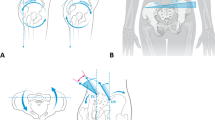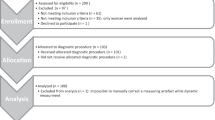Abstract
Purpose
The purpose of this study was to investigate age differences in the response of the spine and pelvis to simulated leg length inequalities (LLIs).
Methods
A total of 107 subjects, separated into three age groups (group 1: 20–39 years, group 2: 40–59 years, group 3: >60 years), were used to evaluate for any age effects in the response to LLIs. LLIs of +10, +20, and +30 mm were simulated with a simulation platform on both sides, and the respective changes of pelvic position (pelvic obliquity, pelvic torsion) and spinal posture (lateral deviation, surface rotation, kyphotic, and lordotic angles) were measured with a rasterstereographic system.
Results
In all three age groups an increase in LLI led to significant changes in the pelvic position as measured by the parameters of pelvic obliquity and torsion. No significant differences in the response of the pelvis to the LLIs were found between the age groups. In all age groups an increase in surface rotation and lateral deviation of the spine with increasing LLIs was found. However, none of these parameters responded significantly different between the three age groups.
Conclusions
Under static conditions, LLIs lead to significant changes of the pelvic position and spinal posture. Despite all known age-related changes, no significant differences of the measured pelvic and spinal parameters in elderly patients as a response to the simulated LLIs occurred.





Similar content being viewed by others
References
Woerman AL, Binder-Macleod SA (1984) Leg length discrepancy assessment: accuracy and precision in five clinical methods of evaluation. J Orthop Sports Phys Ther 5:230–239 (2107 [pii])
Kaufman KR, Miller LS, Sutherland DH (1996) Gait asymmetry in patients with limb-length inequality. J Pediatr Orthop 16:144–150
Gurney B (2002) Leg length discrepancy. Gait Posture 15:195–206
Brunet ME, Cook SD, Brinker MR, Dickinson JA (1990) A survey of running injuries in 1505 competitive and recreational runners. J Sports Med Phys Fit 30:307–315
Blanke DJ, Hageman PA (1989) Comparison of gait of young men and elderly men. Phys Ther 69:144–148
Betsch M, Rapp W, Przibylla A, Jungbluth P, Hakimi M, Schneppendahl J, Thelen S, Wild M (2013) Determination of the amount of leg length inequality that alters spinal posture in healthy subjects using rasterstereography. Eur Spine J. doi:10.1007/s00586-013-2720-x
Betsch M, Schneppendahl J, Dor L, Jungbluth P, Grassmann JP, Windolf J, Thelen S, Hakimi M, Rapp W, Wild M (2011) Influence of foot positions on the spine and pelvis. Arthritis Care Res (Hoboken) 63:1758–1765. doi:10.1002/acr.20601
Betsch M, Wild M, Grosse B, Rapp W, Horstmann T (2012) The effect of simulating leg length inequality on spinal posture and pelvic position: a dynamic rasterstereographic analysis. Eur Spine J. doi:10.1007/s00586-011-1912-5
Drerup B, Hierholzer E (1987) Movement of the human pelvis and displacement of related anatomical landmarks on the body surface. J Biomech 20:971–977
Drerup B, Hierholzer E (1985) Objective determination of anatomical landmarks on the body surface: measurement of the vertebra prominens from surface curvature. J Biomech 18:467–474
Drerup B, Hierholzer E (1987) Automatic localization of anatomical landmarks on the back surface and construction of a body-fixed coordinate system. J Biomech 20:961–970
Drerup B, Hierholzer E (1992) Evaluation of frontal radiographs of scoliotic spines—Part II. Relations between lateral deviation, lateral tilt and axial rotation of vertebrae. J Biomech 25:1443–1450
Drerup B, Hierholzer E (1992) Evaluation of frontal radiographs of scoliotic spines—Part I. Measurement of position and orientation of vertebrae and assessment of clinical shape parameters. J Biomech 25:1357–1362
Mohokum M, Mendoza S, Udo W, Sitter H, Paletta JR, Skwara A (2010) Reproducibility of rasterstereography for kyphotic and lordotic angles, trunk length, and trunk inclination: a reliability study. Spine (Phila Pa 1976) 35:1353–1358. doi:10.1097/BRS.0b013e3181cbc157
Schulein S, Mendoza S, Malzkorn R, Harms J, Skwara A (2013) Rasterstereographic evaluation of interobserver and intraobserver reliability in postsurgical adolescent idiopathic scoliosis patients. J Spinal Disord Tech 26:E143–E149. doi:10.1097/BSD.0b013e318281608c
Lee LW, Zavarei K, Evans J, Lelas JJ, Riley PO, Kerrigan DC (2005) Reduced hip extension in the elderly: dynamic or postural? Arch Phys Med Rehabil 86:1851–1854. doi:10.1016/j.apmr.2005.03.008
Kerrigan DC, Lee LW, Nieto TJ, Markman JD, Collins JJ, Riley PO (2000) Kinetic alterations independent of walking speed in elderly fallers. Arch Phys Med Rehabil 81:730–735
Watelain E, Barbier F, Allard P, Thevenon A, Angue JC (2000) Gait pattern classification of healthy elderly men based on biomechanical data. Arch Phys Med Rehabil 81:579–586
Chen CP, Chen MJ, Pei YC, Lew HL, Wong PY, Tang SF (2003) Sagittal plane loading response during gait in different age groups and in people with knee osteoarthritis. Am J Phys Med Rehabil 82:307–312. doi:10.1097/01.PHM.0000056987.33630.56
Frerich JM, Hertzler K, Knott P, Mardjetko S (2012) Comparison of radiographic and surface topography measurements in adolescents with idiopathic scoliosis. Open Orthop J 6:261–265. doi:10.2174/1874325001206010261
Guidetti L, Bonavolonta V, Tito A, Reis VM, Gallotta MC, Baldari C (2013) Intra- and inter-day reliability of spine rasterstereography. Biomed Res Int 2013:745480. doi:10.1155/2013/745480
Hackenberg L, Hierholzer E (2002) 3-D back surface analysis of severe idiopathic scoliosis by rasterstereography: comparison of rasterstereographic and digitized radiometric data. Stud Health Technol Inform 88:86–89
Goh S, Price RI, Leedman PJ, Singer KP (2000) A comparison of three methods for measuring thoracic kyphosis: implications for clinical studies. Rheumatology (Oxford) 39:310–315
Crawford RJ, Price RI, Singer KP (2009) The effect of interspinous implant surgery on back surface shape and radiographic lumbar curvature. Clin Biomech (Bristol, Avon) 24:467–472. doi: 10.1016/j.clinbiomech.2009.04.003
Goh SPR, Leedman PJ, Singer KP (1999) Rasterstereographic analysis of the thoracic sagittal curvature: a reliability study. J Muscoskel Res 3:137–142
Drerup B, Ellger B, Meyer zu Bentrup FM, Hierholzer E (2001) Functional rasterstereographic images. A new method for biomechanical analysis of skeletal geometry. Orthopade 30:242–250
Young RS, Andrew PD, Cummings GS (2000) Effect of simulating leg length inequality on pelvic torsion and trunk mobility. Gait Posture 11:217–223
Thurston AJ (1985) Spinal and pelvic kinematics in osteoarthrosis of the hip joint. Spine (Phila Pa 1976) 10:467–471
Friberg O (1983) Clinical symptoms and biomechanics of lumbar spine and hip joint in leg length inequality. Spine (Phila Pa 1976) 8:643–651
Morscher E (1977) Etiology and pathophysiology of leg length discrepancies. Springer, Berlin
Irvin RE (1991) Reduction of lumbar scoliosis by use of a heel lift to level the sacral base. J Am Osteopath Assoc 91(34):37–44
Kado DM, Browner WS, Palermo L, Nevitt MC, Genant HK, Cummings SR (1999) Vertebral fractures and mortality in older women: a prospective study. Study of Osteoporotic Fractures Research Group. Arch Intern Med 159:1215–1220
Takeda N, Kobayashi T, Atsuta Y, Matsuno T, Shirado O, Minami A (2009) Changes in the sagittal spinal alignment of the elderly without vertebral fractures: a minimum 10-year longitudinal study. J Orthop Sci 14:748–753. doi:10.1007/s00776-009-1394-z
Legaye J, Duval-Beaupere G, Hecquet J, Marty C (1998) Pelvic incidence: a fundamental pelvic parameter for three-dimensional regulation of spinal sagittal curves. Eur Spine J 7:99–103
Conflict of interest
None.
Author information
Authors and Affiliations
Corresponding author
Rights and permissions
About this article
Cite this article
Wild, M., Kühlmann, B., Stauffenberg, A. et al. Does age affect the response of pelvis and spine to simulated leg length discrepancies? A rasterstereographic pilot study. Eur Spine J 23, 1449–1456 (2014). https://doi.org/10.1007/s00586-013-3152-3
Received:
Revised:
Accepted:
Published:
Issue Date:
DOI: https://doi.org/10.1007/s00586-013-3152-3




